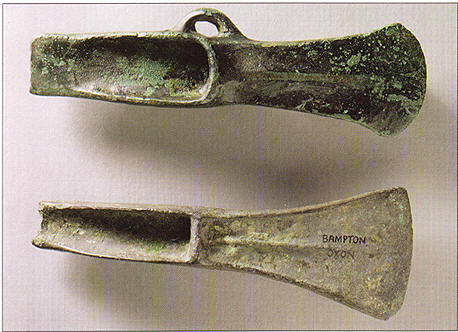Bronze Age Weapons
New
technologies to refine, smelt and cast metal ores
were first used during the Bronze Age
(c.3500—700BC). Early civilizations in the Middle
East began to combine bronze or copper alloys to
produce spears, daggers, swords and axes. Later, swordsmiths started producing finely detailed swords
with stronger iron blades. These techniques spread
to China, India, South-east Asia and Europe, where
they would have a profound influence on future
warfare.

This short sword was made between 3200 and 1150BC.
The decorated hilt and round pommel were later
replacements.
Early Metal Weapons
With the
introduction of copper alloys (90 percent copper
and 10 percent tin), the bronzesmith was able to
produce a much harder metal. Its hardness and
consequent durability were wholly dependent on the
temperature that could be achieved during smelting.
The higher the temperature, the harder the metal
would become. Iron ore was also discovered and soon
became the material of choice for the production of
bladed weapons. Iron ore was abundant and, like
copper alloys, it could be heated to high
temperatures by using charcoal. Immersion of the
blade in water and continuous hammering to form a
well-tempered blade developed a consistent surface
that was less prone to fracture and breakage than
bronze or copper. Most blades would have been cast
in stone, metal or clay moulds.
The sword in Europe from c.2000BC
Although it is
difficult to date precisely when the sword was first
introduced into Europe, there is general agreement
that long-bladed swords were being manufactured
around 2000BC. Their appearance in Europe was
probably independent of earlier developments in
metalworking seen in the Near East and the Aegean.
Distinctive flint swords have been found from this
date in Denmark and northern Europe, including
riveted bronze swords with triangular blades from
the early Bronze Age.
In the later Bronze Age, swords
were cast in one piece, including the grip and
pommel (the knob at the top of the handle or hilt).
Many differing pommel
shapes also emerged. One of the most common swords
is the antenna (or voluted) sword. This had a two-
pronged or scrolled, inwardly curving pommel, said
to represent the outstretched hands of a human
figure. Sword shapes also varied, from broad-leaf
shapes to straight forms that featured grooves,
sometimes erroneously described as “blood channels”,
but more likely to have been designed to provide a
lighter and more easily wielded sword.
The Carp’s Tongue Sword
Common in western and
eastern Europe around 1000BC were a group of bronze
swords known as “carp’s tongue” swords. A
significant number of this distinct sword type were
discovered at excavations in the Thames Valley and
Kent during the mid-20th century. The most notable
find was at the Isleham Hoard, in Cambridgeshire,
England. It comprised more than 6,500 objects made
of bronze, including many swords of carp’s tongue
design. They had wide, tapering blades which were
useful for slashing, with a thinner, elongated end
suitable for stabbing. This style of sword is
thought to have originated in northwestern France.
The Socketed Axe
Another important
military innovation of the Bronze Age Mesopotamian
armies in the Middle East, and one that would have
an enormous impact on future
battlefield warfare, was the introduction of the
socketed axe. Previously, ancient axe makers had
struggled to keep the axehead firmly attached to the
haft (the handle), especially when handling the axe
with considerable force. The Sumerians devised a
cast bronze socket that slipped over the haft and
was secured with rivets. Its development was
probably a consequence of the introduction of
primitive forms of body armour and the need to
penetrate this armour with sufficient force. Later
axes would have narrower points that could be used
to penetrate bronze plate armour. The axe would
remain an integral battle weapon for the next 2,000
years.

A
complete Bronze Age sword (top) with hilt and
leaf-shaped blade (c.1100BC),
and a large bronze spearhead (bottom) from 700BC.

These Bronze Age socketed axes were used as both
domestic tools and
close-quarter combat weapons.
The Sickle Sword of Mesopotamia
One of the earliest societies in which organized
warfare was waged was the Sumerian culture of
southern Mesopotamia (c.3000BC). Even at this early
stage of human civilization, professional standing
armies were being used to defend communities.
Although the most common weapons used by the
Sumerians, and later the Assyrians (c.1100—600BC),
included the spear and bow, warriors also carried a
sharply curved sickle sword.
Introduced around 2500BC, this all-metal sword had a
single-handed grip and a blade of around three grip
lengths. A stunning example in the British Museum,
London, England, has the following inscription on
the blade:
Palace of Adad-nirar, king of the universe, son of Arik-den-ili,
king of Assyria, son of Enlil-nirari, king of
Assyria.
It is believed that this sword was owned by the
Assyrian king Adad-nirari I, who conquered northern
Mesopotamia
(c.1307—1275BC). Mesopotamian art frequently depicts
the sickle sword as a symbol of authority, and it is
often seen placed in the hands of gods and kings.

An illustration of a
sickle sword, 1307—1275BC,
from the Middle Assyrian period (the reign of
Adad-nirari I). |